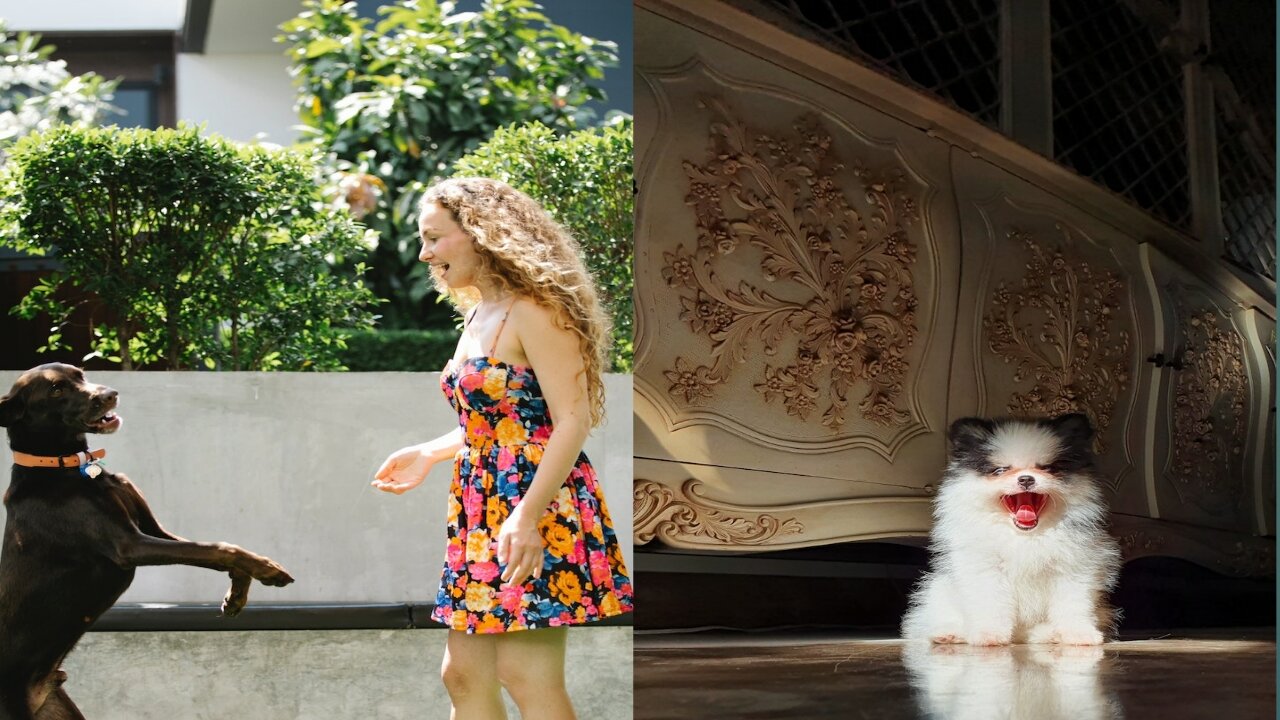Premium Only Content

Cute baby cat | cat video
The cat (Felis catus) is a domestic species of small carnivorous mammal.[1][2] It is the only domesticated species in the family Felidaeand is sometimes referred to as the domestic cat or house cat to distinguish it from the wild members of the family.[4] A cat can either be a house cat, a farm cat, or a feral cat; the latter ranges freely and avoids human contact.[5]Domestic cats are valued by humans for companionship and their ability to kill rodents. About 60 cat breeds are recognized by various cat registries.[6]
Scientific classification edit
Kingdom:
Animalia
Phylum:
Chordata
Class:
Mammalia
Order:
Carnivora
Suborder:
Feliformia
Family:
Felidae
Subfamily:
Felinae
Genus:
Felis
Species:
F. catus[1]
Binomial name
Felis catus[1]
Linnaeus, 1758[2]
Synonyms
Catus domesticus Erxleben, 1777[3]
F. angorensis Gmelin, 1788
F. vulgaris Fischer, 1829
The cat is similar in anatomy to the other felid species: it has a strong flexible body, quick reflexes, sharp teeth, and retractable claws adapted to killing small prey. Its night vision and sense of smell are well developed. Cat communication includes vocalizations like meowing, purring, trilling, hissing, growling, and grunting as well as cat-specific body language. A predator that is most active at dawn and dusk (crepuscular), the cat is a solitary hunter but a social species. It can hear sounds too faint or too high in frequency for human ears, such as those made by mice and other small mammals.[7] Cats also secrete and perceive pheromones.[8]
Female domestic cats can have kittens from spring to late autumn, with litter sizes often ranging from two to five kittens.[9] Domestic cats are bred and shown at events as registered pedigreed cats, a hobby known as cat fancy. Population control of cats may be effected by spaying and neutering, but their proliferation and the abandonment of pets has resulted in large numbers of feral cats worldwide, contributing to the extinction of entire bird, mammal, and reptile species.[10]
It was long thought that cat domestication began in ancient Egypt, where cats were venerated from around 3100 BC,[11][12] but recent advances in archaeology and genetics have shown that their domestication occurred in Western Asia around 7500 BC.[13]
As of 2021, there were an estimated 220 million owned and 480 million stray cats in the world.[14][15] As of 2017, the domestic cat was the second most popular pet in the United States, with 95.6 million cats owned[16][17][18] and around 42 million households own at least one cat.[19] In the United Kingdom, 26% of adults have a cat with an estimated population of 10.9 million pet cats as of 2020.[20]The origin of the English word cat, Old English catt, is thought to be the Late Latin word cattus, which was first used at the beginning of the 6th century.[21] It was suggested that the word 'cattus' is derived from an Egyptian precursor of Coptic ϣⲁⲩ šau, "tomcat", or its feminine form suffixed with -t.[22] The Late Latin word may be derived from another Afro-Asiatic[23] or Nilo-Saharan language. The Nubian word kaddîska "wildcat" and Nobiin kadīs are possible sources or cognates.[24] The Nubian word may be a loan from Arabic قَطّ qaṭṭ ~ قِطّ qiṭṭ. It is "equally likely that the forms might derive from an ancient Germanic word, imported into Latin and thence to Greek and to Syriac and Arabic".[25] The word may be derived from Germanic and Northern European languages, and ultimately be borrowed from Uralic, cf. Northern Sami gáđfi, "female stoat", and Hungarian hölgy, "lady, female stoat"; from Proto-Uralic *käďwä, "female (of a furred animal)".[26]
The English puss, extended as pussy and pussycat, is attested from the 16th century and may have been introduced from Dutch poes or from Low German puuskatte, related to Swedish kattepus, or Norwegian pus, pusekatt. Similar forms exist in Lithuanian puižė and Irish puisín or puiscín. The etymology of this word is unknown, but it may have simply arisen from a sound used to attract a cat.[27][28]
A male cat is called a tom or tomcat[29] (or a gib,[30] if neutered). An unspayed female is called a queen,[31] (or a molly,[32] if spayed), especially in a cat-breeding context. A juvenile cat is referred to as a kitten. In Early Modern English, the word kitten was interchangeable with the now-obsolete word catling.[33] A group of cats can be referred to as a clowder or a glaring.[34]
The scientific name Felis catus was proposed by Carl Linnaeus in 1758 for a domestic cat.[1][2] Felis catus domesticus was proposed by Johann Christian Polycarp Erxleben in 1777.[3] Felis daemon proposed by Konstantin Alekseevich Satunin in 1904 was a black cat from the Transcaucasus, later identified as a domestic cat.[35][36]
In 2003, the International Commission on Zoological Nomenclature ruled that the domestic cat is a distinct species, namely Felis catus.[37][38] In 2007, it was considered a subspecies, F. silvestris catus, of the European wildcat (F. silvestris) following results of phylogenetic research.[39][40] In 2017, the IUCN Cat Classification Taskforce followed the recommendation of the ICZN in regarding the domestic cat as a distinct species, Felis catus.[41]The domestic cat is a member of the Felidae, a family that had a common ancestor about 10–15 million years ago.[42] The genus Felis diverged from other Felidae around 6–7 million years ago.[43] Results of phylogenetic research confirm that the wild Felis species evolved through sympatric or parapatric speciation, whereas the domestic cat evolved through artificial selection.[44] The domesticated cat and its closest wild ancestor are diploid and both possess 38 chromosomes[45] and roughly 20,000 genes.[46] The leopard cat (Prionailurus bengalensis) was tamed independently in China around 5500 BC. This line of partially domesticated cats leaves no trace in the domestic cat populations of today.[47]The earliest known indication for the tamingof an African wildcat (F. lybica) was excavatedclose by a human Neolithic grave in Shillourokambos, southern Cyprus, dating to about 7500–7200 BC. Since there is no evidence of native mammalian fauna on Cyprus, the inhabitants of this Neolithic village most likely brought the cat and other wild mammals to the island from the Middle Eastern mainland.[48] Scientists therefore assume that African wildcats were attracted to early human settlements in the Fertile Crescent by rodents, in particular the house mouse (Mus musculus), and were tamed by Neolithic farmers. This mutual relationship between early farmers and tamed cats lasted thousands of years. As agricultural practicesspread, so did tame and domesticated cats.[13][6] Wildcats of Egypt contributed to the maternal gene pool of the domestic cat at a later time.[49]
The earliest known evidence for the occurrence of the domestic cat in Greecedates to around 1200 BC. Greek, Phoenician, Carthaginian and Etruscan traders introduced domestic cats to southern Europe.[50] During the Roman Empire they were introduced to Corsica and Sardinia before the beginning of the 1st millennium.[51] By the 5th century BC, they were familiar animals around settlements in Magna Graecia and Etruria.[52]By the end of the Western Roman Empire in the 5th century, the Egyptian domestic cat lineage had arrived in a Baltic Sea port in northern Germany.[49]
During domestication, cats have undergone only minor changes in anatomy and behavior, and they are still capable of surviving in the wild. Several natural behaviors and characteristics of wildcats may have pre-adapted them for domestication as pets. These traits include their small size, social nature, obvious body language, love of play and relatively high intelligence. Captive Leopardus cats may also display affectionate behavior toward humans but were not domesticated.[53] House cats often mate with feral cats,[54] producing hybrids such as the Kellas cat in Scotland.[55] Hybridisation between domestic and other Felinae speciesis also possible.[56]
Development of cat breeds started in the mid 19th century.[57] An analysis of the domestic cat genome revealed that the ancestral wildcat genome was significantly altered in the process of domestication, as specific mutations were selected to develop cat breeds.[58] Most breeds are founded on random-bred domestic cats. Genetic diversityof these breeds varies between regions, and is lowest in purebred populations, which show more than 20 deleterious genetic
The domestic cat has a smaller skull and shorter bones than the European wildcat.[60] It averages about 46 cm (18 in) in head-to-body length and 23–25 cm (9–10 in) in height, with about 30 cm (12 in) long tails. Males are larger than females.[61] Adult domestic cats typically weigh between 4 and 5 kg (9 and 11 lb).[44]
Skeleton
Cats have seven cervical vertebrae (as do most mammals); 13 thoracic vertebrae (humans have 12); seven lumbar vertebrae (humans have five); three sacral vertebrae (as do most mammals, but humans have five); and a variable number of caudal vertebrae in the tail (humans have only three to five vestigial caudal vertebrae, fused into an internal coccyx).[62]: 11 The extra lumbar and thoracic vertebrae account for the cat's spinal mobility and flexibility. Attached to the spine are 13 ribs, the shoulder, and the pelvis.[62]: 16 Unlike human arms, cat forelimbs are attached to the shoulder by free-floating clavicle bones which allow them to pass their body through any space into which they can fit their head.[
A cat with its mouth open exposing its teeth
The cat skull is unusual among mammals in having very large eye sockets and a powerful specialized jaw.[64]: 35 Within the jaw, cats have teeth adapted for killing prey and tearing meat. When it overpowers its prey, a cat delivers a lethal neck bite with its two long canine teeth, inserting them between two of the prey's vertebrae and severing its spinal cord, causing irreversible paralysis and death.[65] Compared to other felines, domestic cats have narrowly spaced canine teeth relative to the size of their jaw, which is an adaptation to their preferred prey of small rodents, which have small vertebrae.[65] The premolar and first molar together compose the carnassial pair on each side of the mouth, which efficiently shears meat into small pieces, like a pair of scissors. These are vital in feeding, since cats' small molars cannot chew food effectively, and cats are largely incapable of mastication.[64]: 37 Although cats tend to have better teeth than most humans, with decay generally less likely because of a thicker protective layer of enamel, a less damaging saliva, less retention of food particles between teeth, and a diet mostly devoid of sugar, they are nonetheless subject to occasional tooth loss and infection.[66]
Claws
Shed claw sheaths
Cats have protractible and retractable claws.[67] In their normal, relaxed position, the claws are sheathed with the skin and fur around the paw's toe pads. This keeps the claws sharp by preventing wear from contact with the ground and allows for the silent stalking of prey. The claws on the forefeet are typically sharper than those on the hindfeet.[68] Cats can voluntarily extend their claws on one or more paws. They may extend their claws in hunting or self-defense, climbing, kneading, or for extra traction on soft surfaces. Cats shed the outside layer of their claw sheaths when scratching rough surfaces.[69]
Most cats have five claws on their front paws and four on their rear paws. The dewclaw is proximal to the other claws. More proximally is a protrusion which appears to be a sixth "finger". This special feature of the front paws on the inside of the wrists has no function in normal walking but is thought to be an antiskidding device used while jumping. Some cat breeds are prone to having extra digits ("polydactyly").[70] Polydactylous cats occur along North America's northeast coast and in Great Britain.[71]
Ambulation
The cat is digitigrade. It walks on the toes, with the bones of the feet making up the lower part of the visible leg.[72] Unlike most mammals, it uses a "pacing" gait and moves both legs on one side of the body before the legs on the other side. It registers directly by placing each hind paw close to the track of the corresponding fore paw, minimizing noise and visible tracks. This also provides sure footing for hind paws when navigating rough terrain. As it speeds up from walking to trotting, its gait changes to a "diagonal" gait: The diagonally opposite hind and fore legs move simultaneously.[73]
Balance
0:00
Comparison of cat righting reflexes in gravity and zero gravity
Most breeds of cat are noted fond of sitting in high places, or perching. A higher place may serve as a concealed site from which to hunt; domestic cats strike prey by pouncing from a perch such as a tree branch. Another possible explanation is that height gives the cat a better observation point, allowing it to survey its territory. A cat falling from heights of up to 3 meters (9.8 ft) can right itself and land on its paws.[74]
During a fall from a high place, a cat reflexively twists its body and rights itself to land on its feet using its acute sense of balance and flexibility. This reflex is known as the cat righting reflex.[75] A cat always rights itself in the same way during a fall, if it has enough time to do so, which is the case in falls of 90 cm (2 ft 11 in) or more.[76] How cats are able to right themselves when falling has been investigated as the "falling cat problem".[77]
-
 1:32:56
1:32:56
Glenn Greenwald
5 hours agoPalantir EXPOSED: Spying on Americans & Expanding the Privatized Deep State | SYSTEM UPDATE #465
87K43 -
 LIVE
LIVE
SpartakusLIVE
3 hours agoThe Spartan and The Dragon take on the EASTER EGG Tower || Duos w/ Rallied
278 watching -
 1:53:49
1:53:49
RiftTV/Slightly Offensive
4 hours ago“BRING IN THE TROOPS”: Trump Orders Riot to be SHUT DOWN | The Rift | Guest: Anthony Cabassa
30.9K7 -
 8:59
8:59
MattMorseTV
5 hours ago $0.35 earnedMexico's President just made a BIG MISTAKE.
17.7K30 -
 UPCOMING
UPCOMING
We Like Shooting
14 hours agoWe Like Shooting 614 (Gun Podcast)
137 -
 LIVE
LIVE
PudgeTV
3 hours ago🔵 Mod Mondays Ep 65 | The Italian CEO on Rumble | Business, Pizza & Streaming
88 watching -
 2:22:49
2:22:49
Robert Gouveia
5 hours agoArrest Gavin Newsom?? Insurrection Act! Mexico's Reconquista! Deportation Hearing!
34K38 -
 LIVE
LIVE
House of Jacobs
1 hour agoElden Ring NightReign Zero Skill, Full Send
27 watching -
 LIVE
LIVE
Fragniac
3 hours ago🔴 SPLITGATE 2 *NEW* BATTLE ROYALE w/ The @BrrrapPack ❗
103 watching -
 53:24
53:24
The Daily Signal
2 hours ago $0.44 earned🚨 BREAKING: Democrats Call for Nationwide Mobilization, U.S. Marines Deployed to Los Angeles
18.8K2